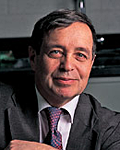Counter Intuitive Physics of Ballistic Transport in the State-of-the-Art Electronic Devices
Category
Published on
Abstract
Philip F. Bagwell Honorary Lecture - A lecture Series held in fond memory of Philip F. Bagwell, former Professor in Electrical and Computer Engineering, to celebrate his spirit of deep thinking across disciplines.
In a small enough semiconductor devices, the electron mean free path for collisions with impurities or lattice vibrations greatly exceeds the device size. Hence, the electrons travelling with the thermal or Fermi velocity leave the active region of the device before they experience scattering. Such collisionless electron transport is called "ballistic". The electron mean free path in silicon at room temperature (on the order of 30 nm) is much greater than the 10 or 12 nm feature size of modern silicon CMOS used, for example, in the recent generations of iPhones or android phones. The current-voltage characteristics of such devices look similar to those of much longer transistors. However, the physics of the ballistic transport hiding behind this misleading similarity is very different and counter intuitive. It has important qualitative consequences for the design of the advanced transistors and integrated circuits. One new ballistic concept the concept of a "ballistic mobility". A mobility is the coefficient of proportionality between the effective drift velocity in the device channel and applied electric field. Since electrons hit contacts more often in short channel devices, the ballistic mobility is proportional to the device length, as was confirmed by numerous experimental data. At high frequencies, the electron inertia starts playing an important or even dominant role. The high frequency impedance is strongly affected by the electron inertia and by the phase delays of the opposing electron fluxes in the device channel. The waves of the electron density (plasma waves) enable the device response well into the terahertz (THz) range of frequencies. At high excitation levels, these waves are transformed into the shock waves. The rectification and instabilities of the plasma waves enable a new generation of THz and sub-THz plasmonic devices. Ultra-wide band WIFI, advanced homeland security, VLSI testing, and cancer detection are but examples of applications of this plasmonic technology.
Bio
 Professor Michael S. Shur obtained an MS degree in Electrical Engineering from the St. Petersburg Electrotechnical University in 1965, and a Ph.D. in Physics from the Ioffe Institute of Physics and Technology in 1967. He worked as a Junior Scientist at the Ioffe Institute and subsequently held research or faculty positions at Wayne State University (MI), Cornell University (NY), Oakland University (MI), the University of Minnesota, and the University of Virginia. In 1996 he joined the Rensselaer Polytechnic Institute (Troy, NY) as the Patricia W. and C. Shelden Roberts Professor of Solid State Electronics in the Departments of Electrical, Computer and Systems Engineering and Physics, Applied Physics and Astronomy. He additionally serves as the Director of the Broadband Center since 2006, and previously presided over the Center for Integrated Electronics and the RPI site of ‘Connection One’. Shur has founded and co-founded four companies and worked as Jefferson Science Fellow in the US Department of State. He provides consulting and technical expertise to a wide array of multinational corporations and patent law firms, and is an Editorial Board member for several scientific journals. His research has been recognized by a series of awards and prizes, garnered over 50,000 publication citations with h-index of 103, and featured in numerous keynote presentations and invited lectures. Shur is a Fellow of the National Academy of Inventors, the Optical Society of America, MRS, IET, the Electrochemical Society, the World Innovation Foundation, AAAS, and the Electromagnetic Academy; a Life Fellow of IEEE and the American Physical Society; and a Fellow and Life Member of SPIE. He received Honorary Doctorates from the St. Petersburg Electrotechnical University and the University of Vilnius, in 1994 and 2016 respectively.
Professor Michael S. Shur obtained an MS degree in Electrical Engineering from the St. Petersburg Electrotechnical University in 1965, and a Ph.D. in Physics from the Ioffe Institute of Physics and Technology in 1967. He worked as a Junior Scientist at the Ioffe Institute and subsequently held research or faculty positions at Wayne State University (MI), Cornell University (NY), Oakland University (MI), the University of Minnesota, and the University of Virginia. In 1996 he joined the Rensselaer Polytechnic Institute (Troy, NY) as the Patricia W. and C. Shelden Roberts Professor of Solid State Electronics in the Departments of Electrical, Computer and Systems Engineering and Physics, Applied Physics and Astronomy. He additionally serves as the Director of the Broadband Center since 2006, and previously presided over the Center for Integrated Electronics and the RPI site of ‘Connection One’. Shur has founded and co-founded four companies and worked as Jefferson Science Fellow in the US Department of State. He provides consulting and technical expertise to a wide array of multinational corporations and patent law firms, and is an Editorial Board member for several scientific journals. His research has been recognized by a series of awards and prizes, garnered over 50,000 publication citations with h-index of 103, and featured in numerous keynote presentations and invited lectures. Shur is a Fellow of the National Academy of Inventors, the Optical Society of America, MRS, IET, the Electrochemical Society, the World Innovation Foundation, AAAS, and the Electromagnetic Academy; a Life Fellow of IEEE and the American Physical Society; and a Fellow and Life Member of SPIE. He received Honorary Doctorates from the St. Petersburg Electrotechnical University and the University of Vilnius, in 1994 and 2016 respectively.
Sponsored by
Cite this work
Researchers should cite this work as follows:
Time
Location
121 Burton Morgan, Purdue University, West Lafayette, IN